Attribute based merchandising
This guide illustrates how to create attribute based ranking rules.
💡Prerequisite knowledge
Boost and Position Lock Your First Product: This gives an overview of ranking specific products. Attribute-based merchandising process is very similar to the process of ranking specific products.
What is Attribute based merchandising
Attribute-based merchandising lets you influence the ranking of a set of products based on specific attributes like color, price, category, etc.
Bloomreach’s algorithms continuously rank, optimize, and personalize the product results for your customers. You can use Attribute-based merchandising rules to combine the algo-optimized results with your strategic product grid customizations.
This allows you to target business KPIs while delivering a relevant search experience to your shoppers.
Product ranking rules vs. Attribute ranking rules
- Product ranking rules let you rank specific products (or product IDs) that you select.
- Attribute ranking rules let you adjust ranking based on product characteristics. These characteristics can apply to multiple products. For example, you may want to boost all items with the color attribute "blue." Bloomreach’s default ranking algorithm determines the precise ranking of products boosted or buried by attribute.
You can combine Product ranking and Attribute ranking rules to support various merchandising use cases and optimize the ranking of specific products in search results.
Attribute ranking rules overview
You can perform attribute-based merchandising for two types of product attributes — Product Description Attributes and Numeric Attributes.
- Product Description Attributes describe the product, like color, silhouette, category, etc.
- Numeric Attributes are product characteristics that can be quantified and expressed as numbers like price, inventory levels, dimensions, etc. Creating a rule by numeric attribute is powerful because Bloomreach can utilize the signals provided by these metrics and incorporate them into the ranking algorithm.
Create attribute ranking rule
Start the same way as you do for a product ranking rule, especially when planning your rule.
1. Navigation
- Go to Merchandising → Site search → Ranking rules.
- Click the + New ranking rule button to create a new ranking rule.
- Enter the desired search term(s) that will trigger the attribute rule. These are the terms that your customers enter when they search for products on your site.
- Now, click the Attribute tab. Click the Create New Attribute Rule button.
2. Select attributes and their values
-
Choose Product Description Attributes or Numeric Attributes per your use case. This opens up a list of attributes to pick from.
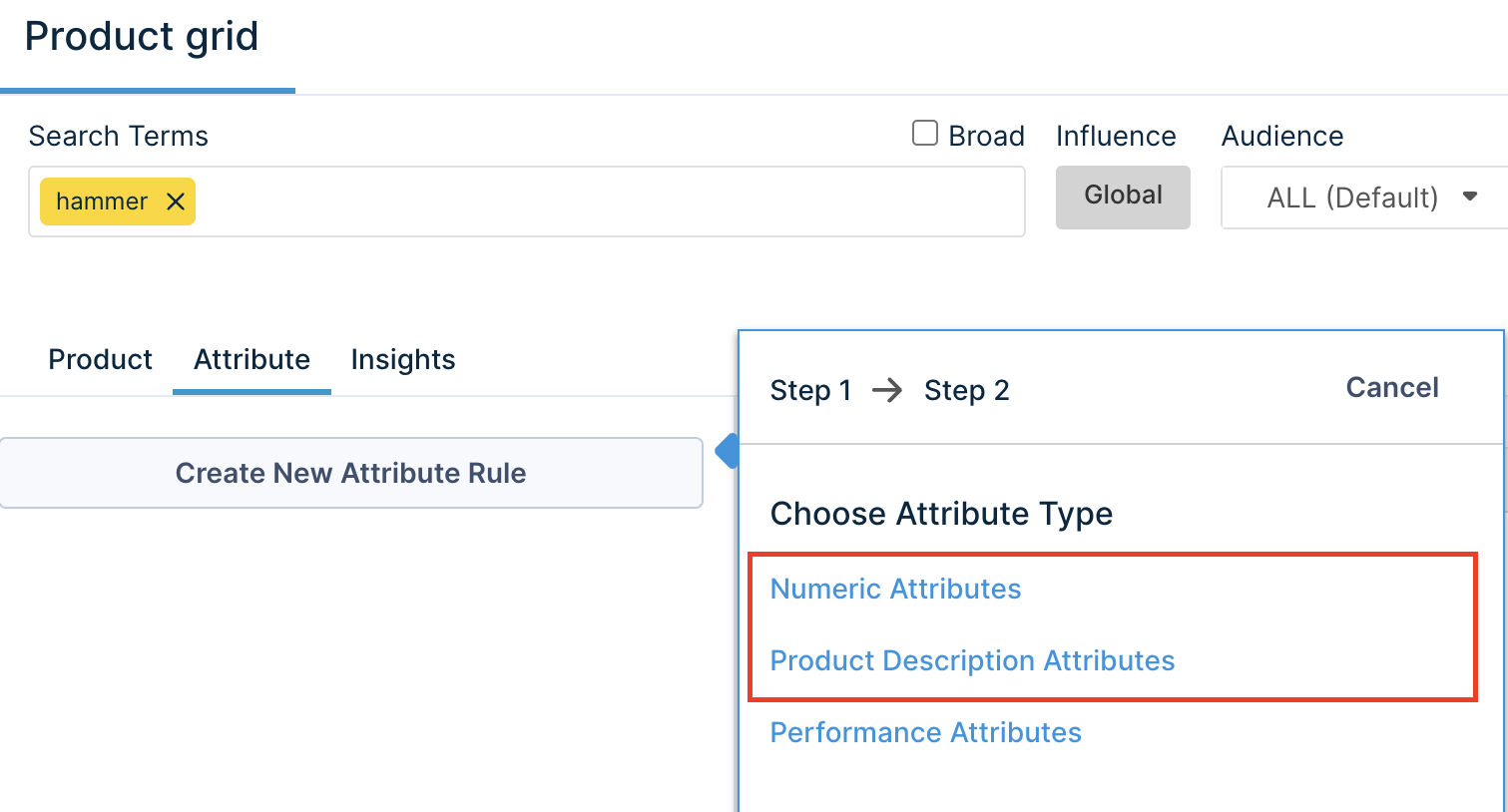
Performance Attributes
You may also come across Performance Attributes. Bloomreach Analytics tracks performance metrics and results of interactions between your site(s) and visitors. These interactions include Visits, Revenue, and Conversions, etc., and they are measured and represented by their respective Performance Attributes. Read more about the process of customizing Performance Attributes.
-
Now, select the product attributes and their values (a maximum of 1024). You're essentially creating attribute-value pairs. You're selecting the specific characteristics that describe the products you want to influence. For example, type is a product attribute, and "4-Cutter" is one of its values.
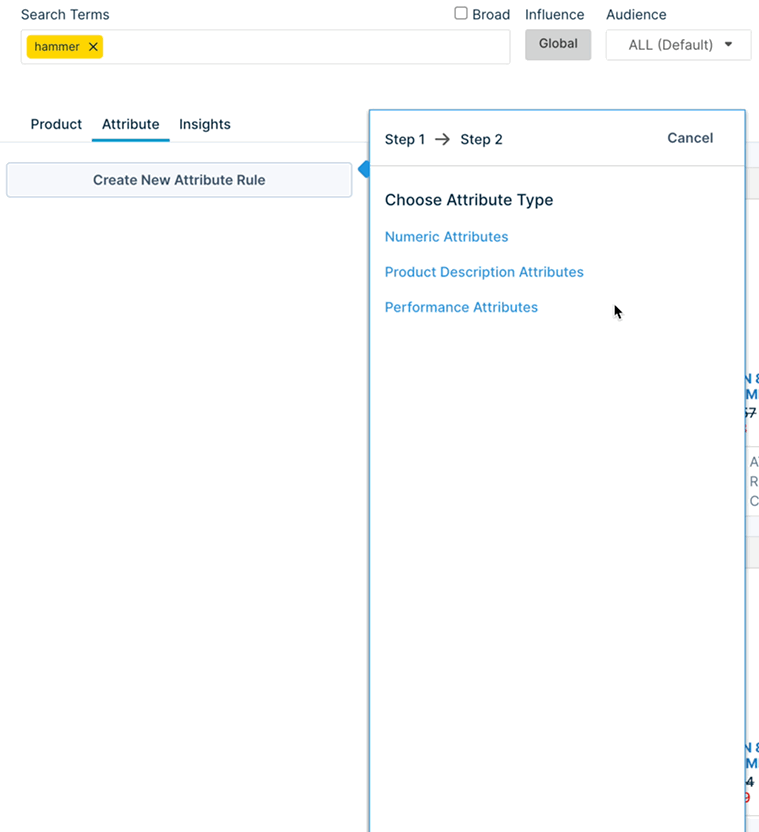
-
The attribute-value pairs available are pulled from your product feed, which is a file that contains all of the products and fields in your site's product catalog. If you can't find the attributes and values you expect, contact your Bloomreach Customer Success Manager (CSM) for help.
3. Choose and configure a ranking operation
You can configure ranking operations for both Product Description and Numeric Attributes. Follow the respective configuration sections for each attribute type.
Product Description Attributes ranking
-
Use the operation dropdown above the attribute list to apply a ranking operation to each product description attribute-value pair.
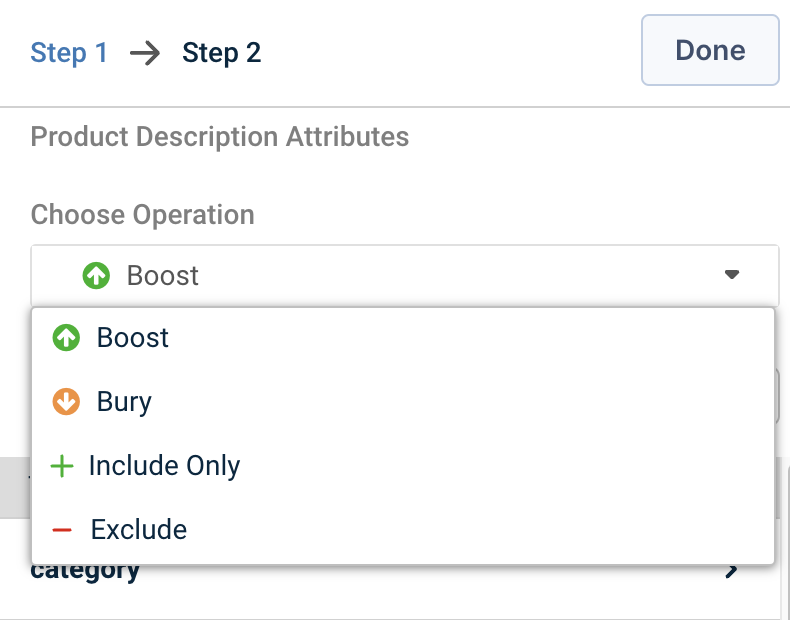
-
Configure the ranking operation for the desired ranking effect. For Boost/Bury, use the Strength slider to set the boost/bury factor.
BoostDrag the Strength slider to set the boost strength and move products closer to the top of the results. The strength of the boost applied to all products will be the same. Imagine you boost products where brand = "Gucci" with a boost factor of 10. Then, all "Gucci" products get the same boost strength of 10.
NOTE: Boost with a strength of 100 is not a hard boost, i.e., it doesn’t move products to the top of search results. Learn more about the differences between soft boosting and hard boosting here.
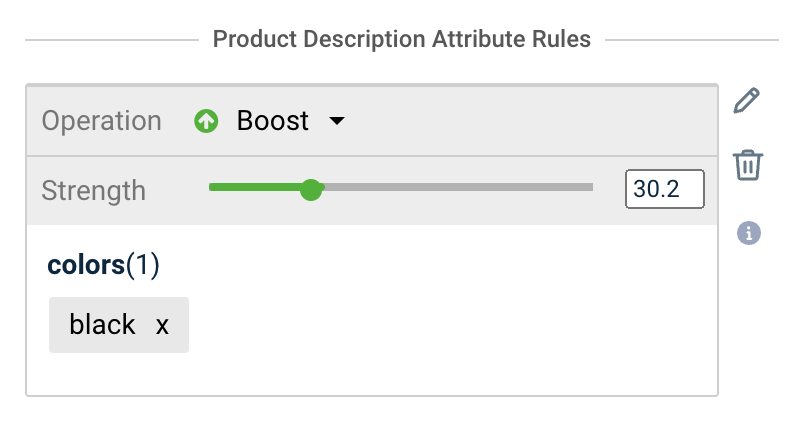
Soft boost feature is powered by Loomi AI
Bury
Drag the Strength slider to set the bury strength and move products closer to the bottom of the results.
NOTE: Bury with a strength of 100 is a hard bury, i.e., it moves products to the bottom of search results.

Include Only
Select to include only products with the selected attribute values in the results.
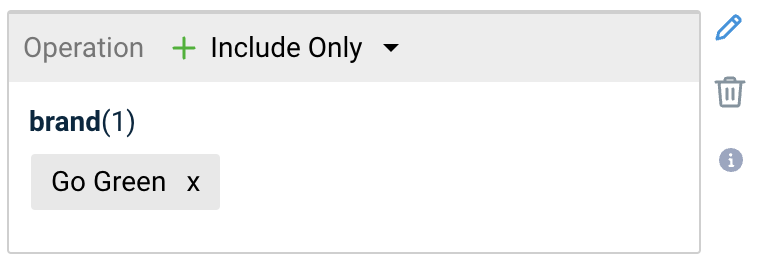
Exclude
Select to exclude products with the selected attribute values in the results.
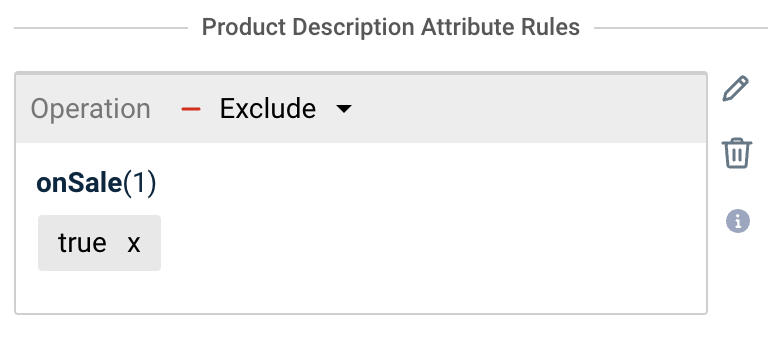
Numeric Attributes ranking
-
Use the operation dropdown above the attribute list to apply a ranking operation to each numeric attribute-value pair.
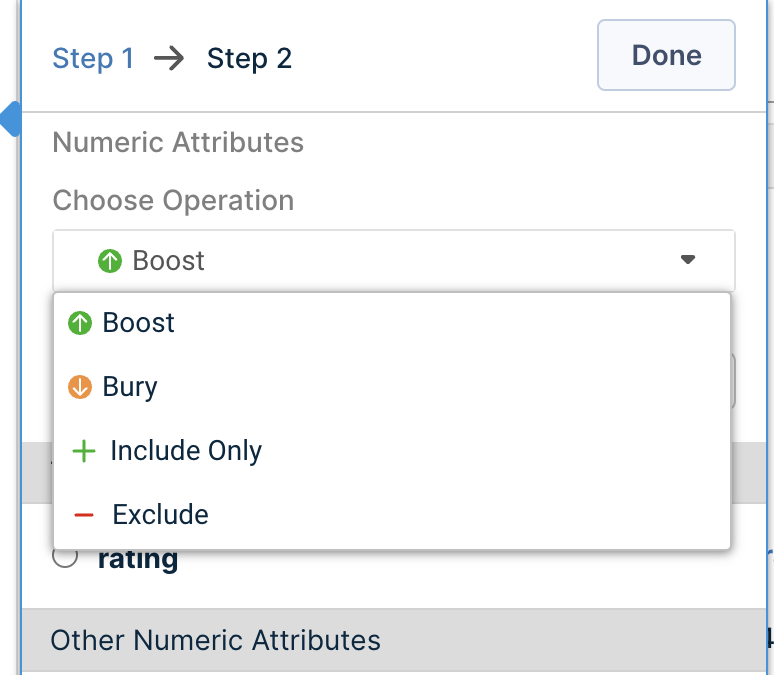
-
Configure the ranking operation for the desired ranking effect.
Boost
-
Drag the Strength slider to set the boost strength and move products closer to the top of the results. For most use cases, the boost should be within the range of 0-25. Queries/Categories with a lot of user behavior data will require greater strength to trump.
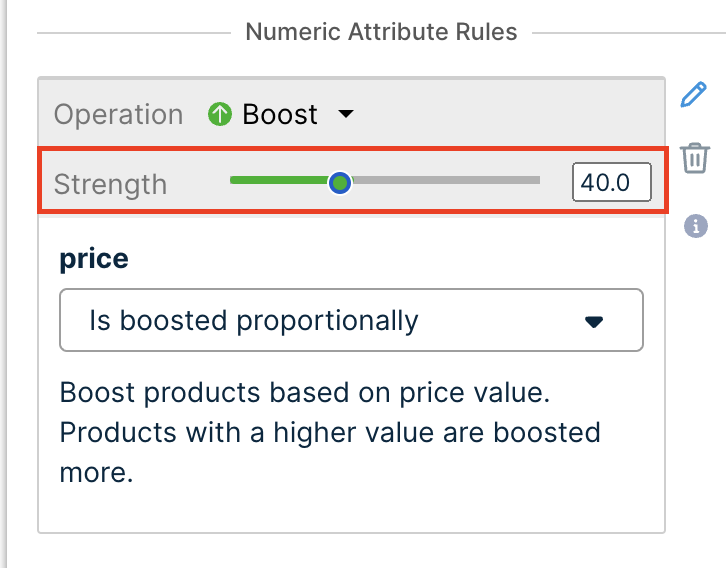
-
Specify the condition that the attribute value must satisfy.
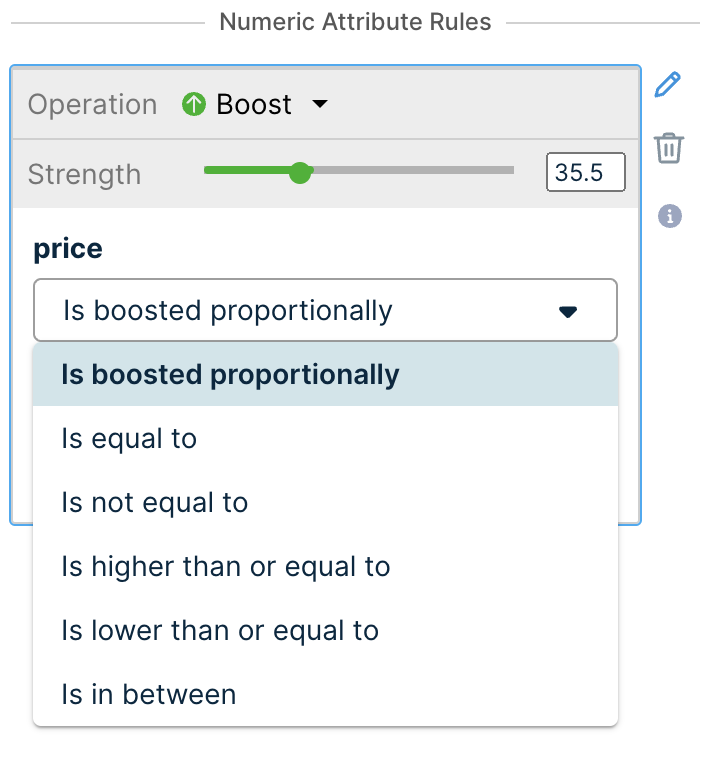
The condition can be one of the following:
- Boost proportionally to attribute value
Products with higher attribute values get a bigger boost. Imagine you boost the numeric attribute price by a factor of 40. Then, products with a higher price will receive a greater boost than those with a lower price, assuming all other factors remain the same. So, with the boost factor 40, a product with a price of "60" will receive a larger boost than a product priced "20". - Equal to a value
- Not equal to a value
- Higher than or equal to a value
- Lower than or equal to a value
- In between a range
Only products that satisfy the attribute value condition will be boosted in the results.
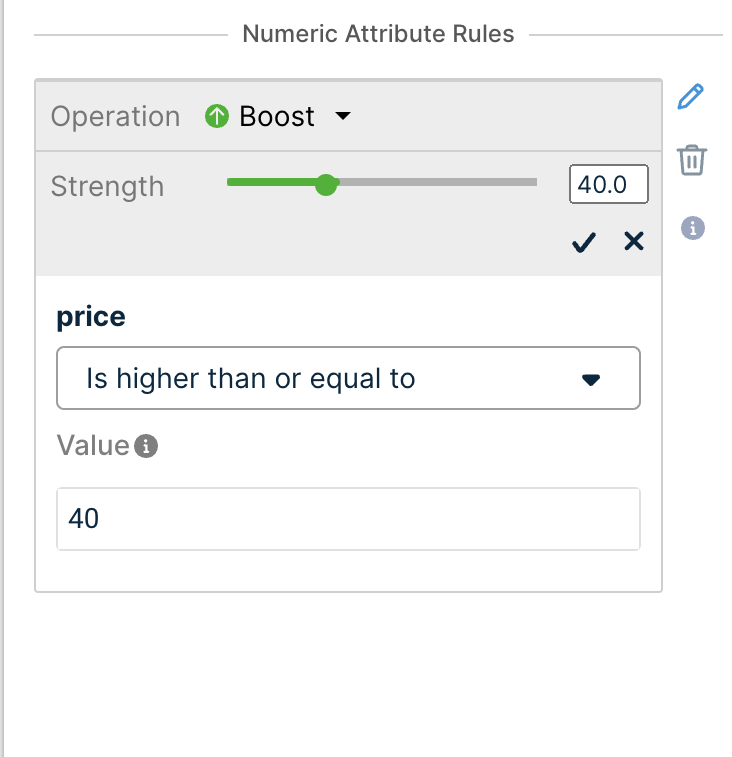
In this example, we boost products priced more than or equal to $40.
Please note that the value unit here is the same as the attribute value unit provided in the feed. For example, if the feed specifies prices in dollars ($), the price value you enter here will also be in dollars ($).
Bury
-
Drag the Strength slider to set the bury strength and move products closer to the bottom of the results.
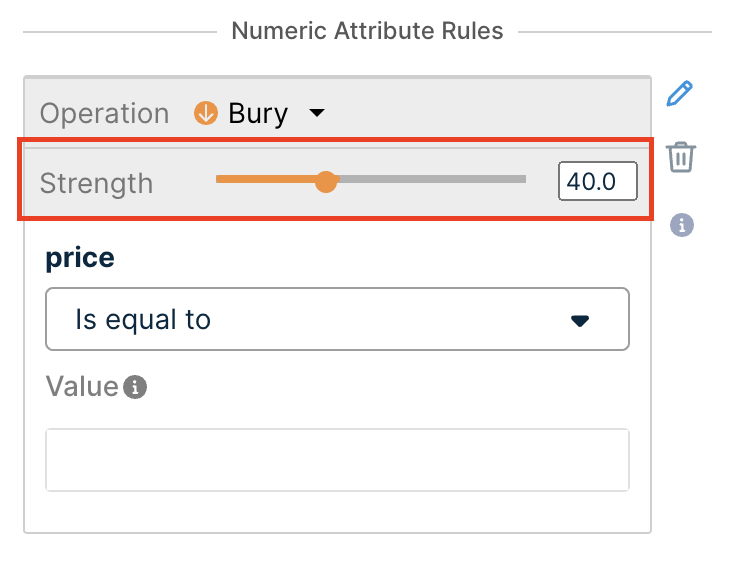
-
Specify the condition that the attribute value must satisfy.
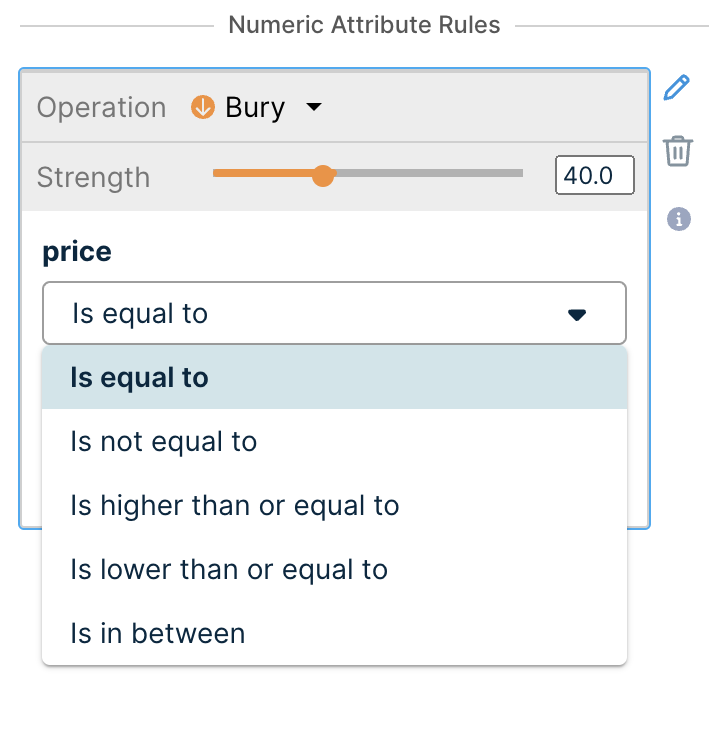
The condition can be one of the following:
- Equal to a value
- Not equal to a value
- Higher than or equal to a value
- Lower than or equal to a value
- In between a range
Only products that satisfy the attribute value condition will be buried in the results.
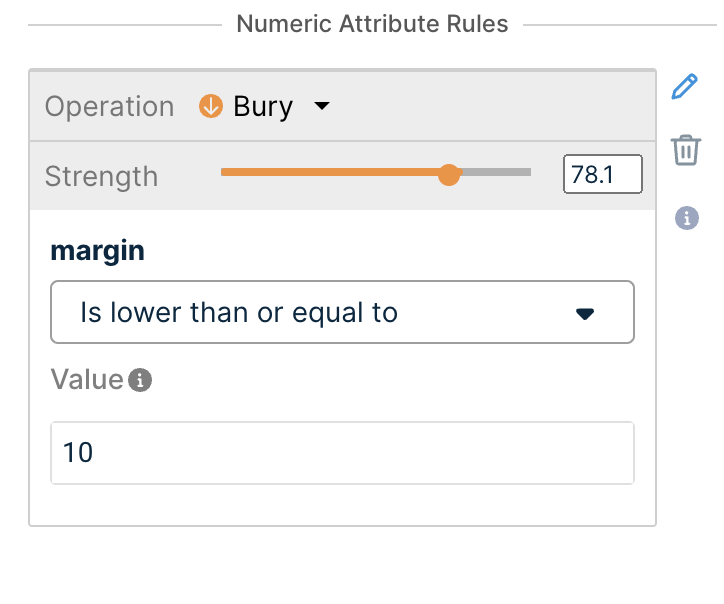
In this example, we bury products priced less than or equal to $10.
Please note that the value unit here is the same as the attribute value unit provided in the feed. For example, if the feed specifies prices in dollars ($), the price value you enter here will also be in dollars ($).
Include Only
Specify the condition that the attribute value must satisfy. This can be equal to a value, higher or lower than a value, or in between a range. Only products that satisfy the attribute value condition will be included in the results.
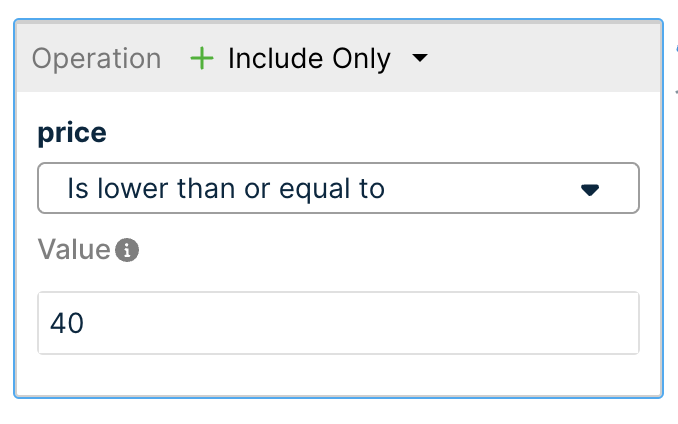
In this example, we include only products priced lower than or equal to $40. Please note that the value unit here is the same as the attribute value unit provided in the feed. For example, if the feed specifies prices in dollars ($), the price value you enter here will also be in dollars ($).
Exclude
Specify the condition that the attribute value must satisfy. This can be equal to a value, higher or lower than a value, or in between a range. Only products that satisfy the attribute value condition will be excluded from the results.
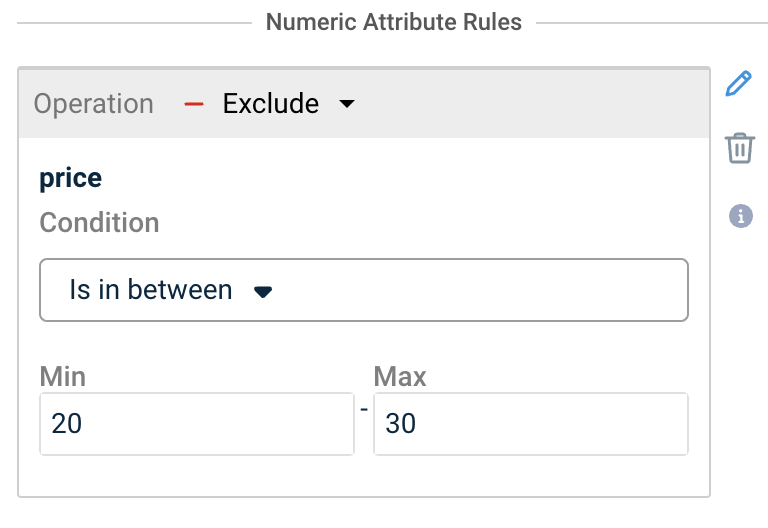
In this example, we exclude only products priced within the range of $20 - $30. Please note that the value unit here is the same as the attribute value unit provided in the feed. For example, if the feed specifies prices in dollars ($), the price value you enter here will also be in dollars ($).
Check the merchandising use cases of numeric attributes ranking operations.
4. Set the rule duration
The default duration is set to All Time, which implies that the rule has no specific end date. To change this, click the dropdown box to see a list of default duration options and choose one that suits your needs. You can also select a Custom Range of your choice.

5. Preview and save the rule
You can click the Preview button to view the changes you have made to this attribute rule. Products with attributes that match your attribute-value pairs appear in the preview on the right side of the page.
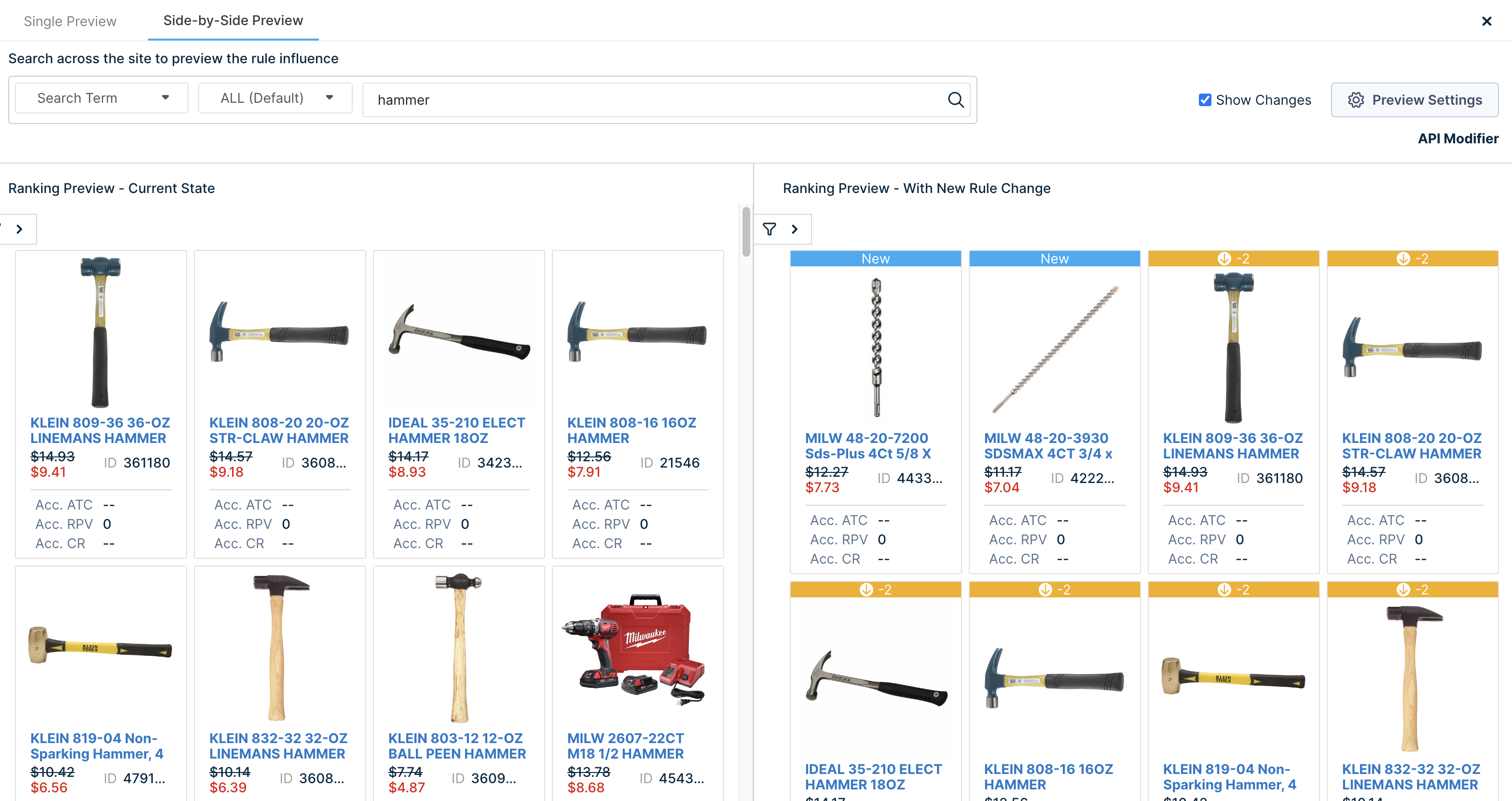
When you’re satisfied with the customizations, click Save.
Notes
-
Soft boost vs. Hard boost
Soft boosting increases the relative weight of the attribute without overriding the algorithm’s ranking. All attributes can receive a soft boost. Note that the soft boost factor is being applied in addition to the Core Ranking Signals, such as user behavior, semantics, and personalization.
This means that if ranking signals change, the products' positions will also change accordingly. If a product underperforms, it will move down in the results, even if you have soft-boosted it.
Hard boosting overrides the algorithm’s product ranking. It moved products to the top of search results. You can hard boost only individual products. To hard boost a product, apply the "Boost to Top" operation in the dashboard.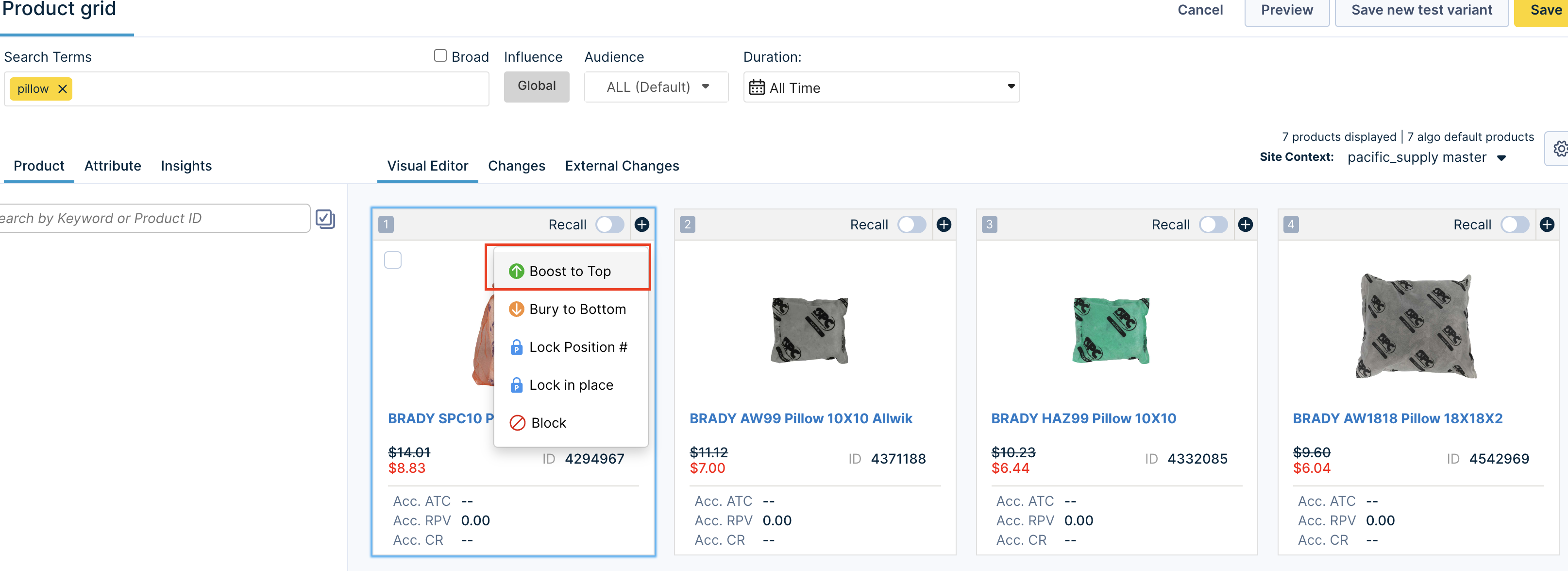
-
Product Description attribute vs. Numeric attribute boosting
For Product Description attributes, the boost applied to all products will be the same. For example, if you are soft boosting products where brand = "Gucci" by a strength of 10, then all "Gucci" products will be given the same boost of 10.
For Numeric Attributes, when you apply a proportional boost, products are boosted based on the absolute value of the attribute. Products with higher attribute values get a bigger boost.
Imagine you choose a proportional boost for the numeric attribute "margin" and set a factor of 10. Then, products with a higher margin will receive a greater boost than those with a lower margin, assuming all other factors remain the same. So, with the proportional boost factor 10, a product with a margin of "35.2" will receive a larger boost than a product with a margin of "8.2".
Use cases
Watch this short demo video on a numeric attribute use case.
Here are some merchandising use cases of operations for Numeric Attributes.
Boost use cases
-
Boost products at a particular price point
In this example, we use the Boost operation to boost products where the numeric attribute price value equals $149.
-
Boost discounted products for clearance sales
In this example, we boost products with a numeric attribute discount value between 5% and 15%.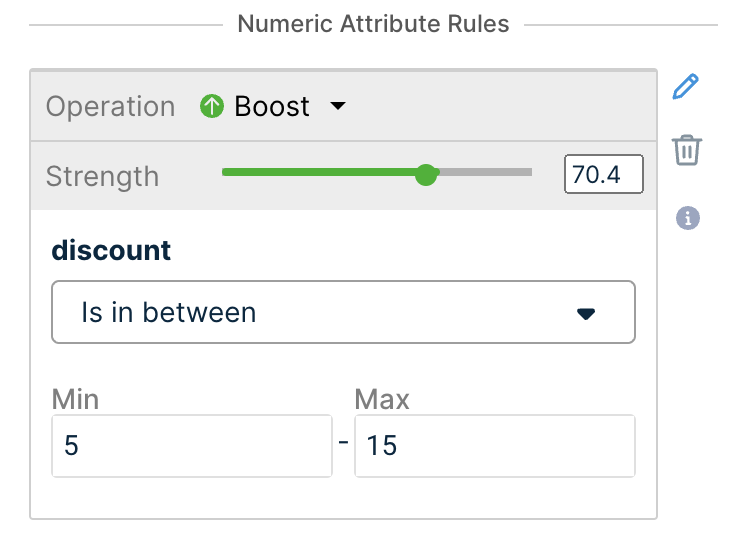
-
Boost products within a specific budget range
In this example, we boost products priced between $20 and $50.
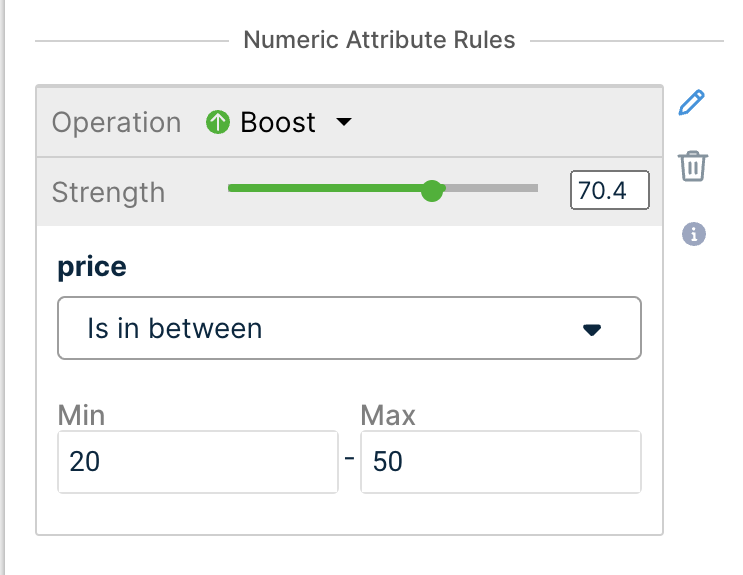
Bury use cases
- Bury less profitable items
In this example, we use the Bury operation to bury products with a numeric attribute margin value lower than or equal to $10.

-
Bury products with low inventory
In this example, we bury products whose inventory_level value is lower than or equal to 5. This means that products with less than or equal to 5 inventory units will be buried in the results.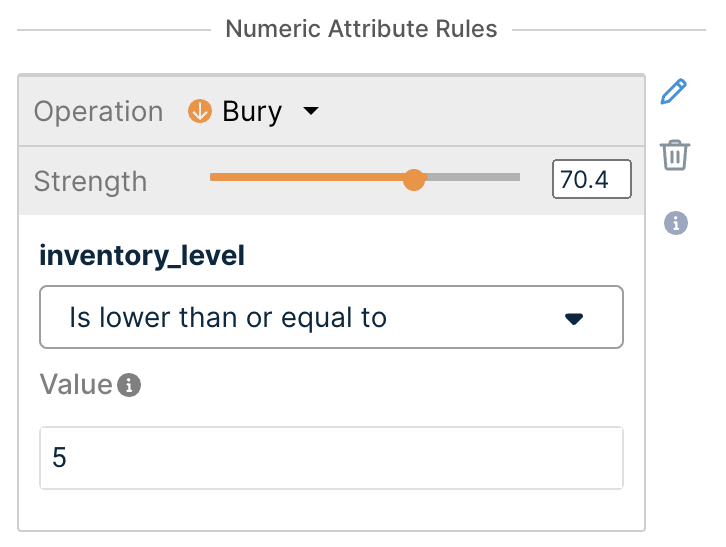
Include only use cases
-
Include only products that are new
In this example, we use the Include Only operation to include only newly launched products. Here, Newness is equal to ”0” implies all products that have that value are treated as new.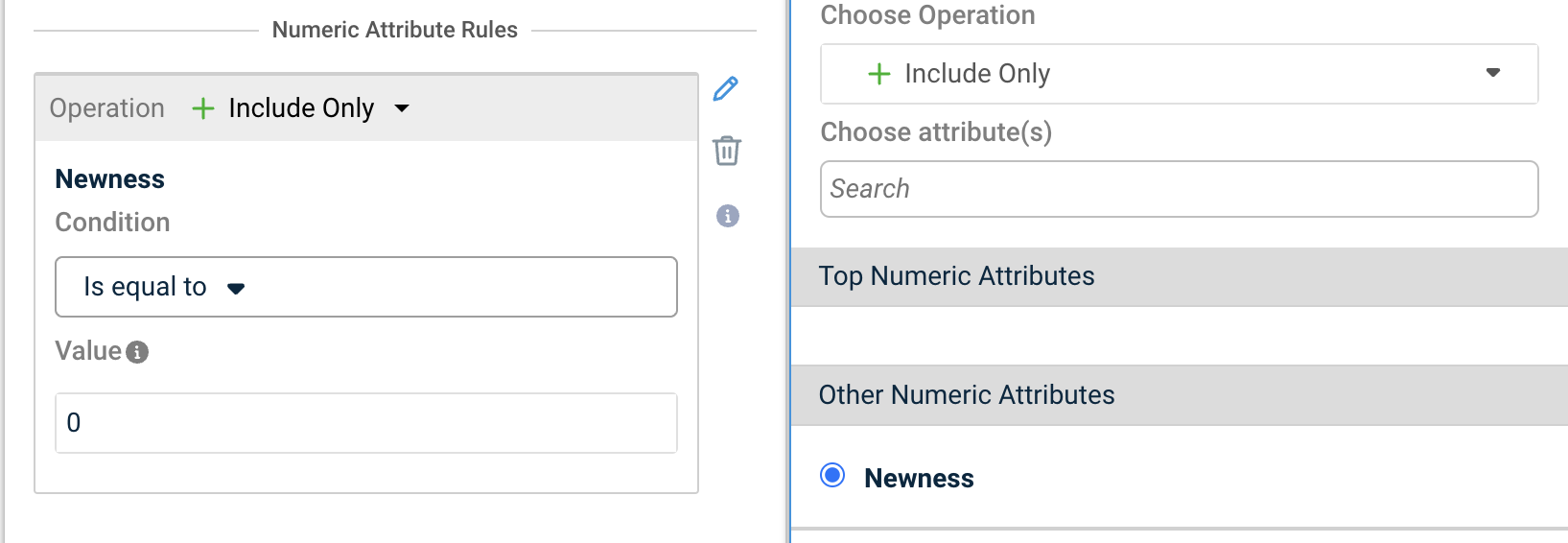
-
Include only products launched after a certain date
In this example, we use the Include Only operation to include only products launched after a certain date. Here, we use the NewnessDate attribute and specify the date’s numeric value. The result set will include only products with a date value higher than the specified number.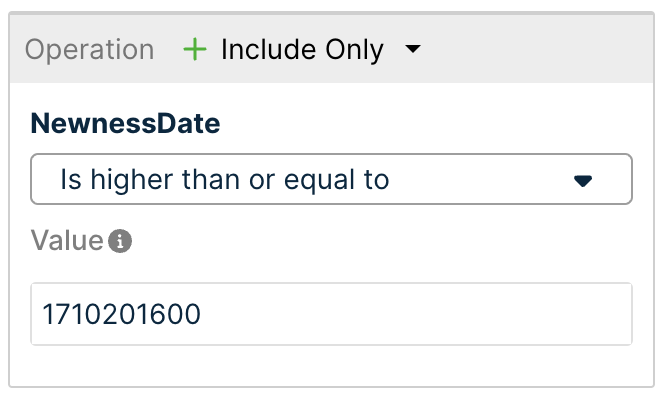
This can be useful for a new promotion campaign to showcase products launched after a certain date. Note that the date value (Unix timestamp or reverse date number) varies as per your implementation.
Exclude use cases
-
Exclude products with low ratings
In this example, we use the Exclude operation to exclude products where the value of the numeric attribute AverageRating is lower than or equal to 3.
-
Exclude products with low prices
In this example, we use the Exclude operation to exclude products where the numeric attribute price value is lower than or equal to $5.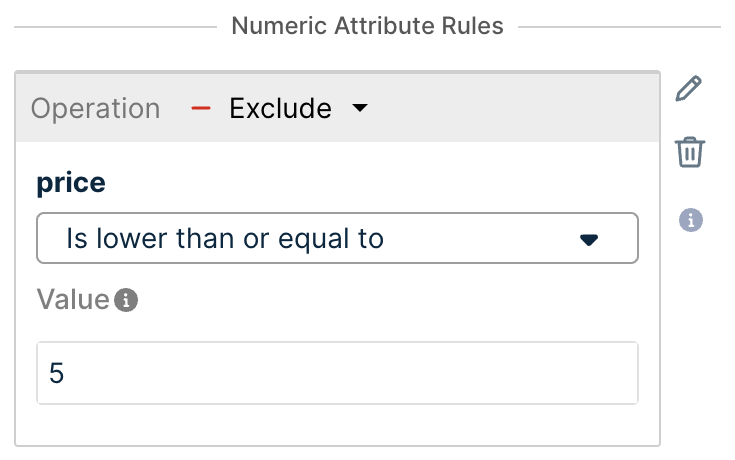
-
Exclude products that are too low in the inventory
In this example, we use the Exclude operation to exclude products where the value of the numeric attribute inventory_level is lower than or equal to 5. This means that products with less than 5 units of inventory will be excluded from the results.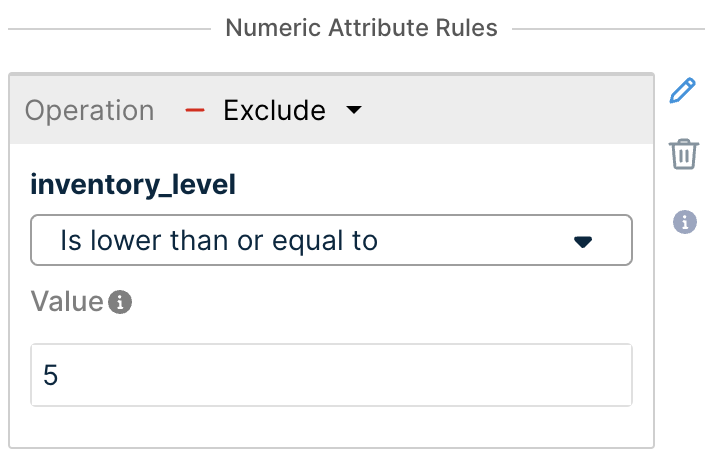
Tip
To view the desired attributes and their values on the product cards, configure the product card data display.
FAQs
-
How are Top Attributes determined?
The attributes that are the most relevant to the customer’s search are listed under the Top Attributes section. -
What happens if one rule boosts an attribute while another rule buries it?
If there are conflicts between a boost rule and a bury rule, then the bury rule takes precedence, and the products are buried. Suppose there’s a product, “Adidas Red hooded shirt”. The below two attribute rules influence the product:
- Bury rule that buries products with the attribute color = ”red”
- Boost rule that boosts products with attribute brand = ”adidas”
When a shopper searches for hooded shirts, the bury rule overrides the boost rule, placing red-colored shirts, including the Adidas Red hooded shirt, at the bottom of search results.
To understand how conflict resolution is handled and how the order of priority works, go to the Conflict Resolution page.
Updated 9 months ago
